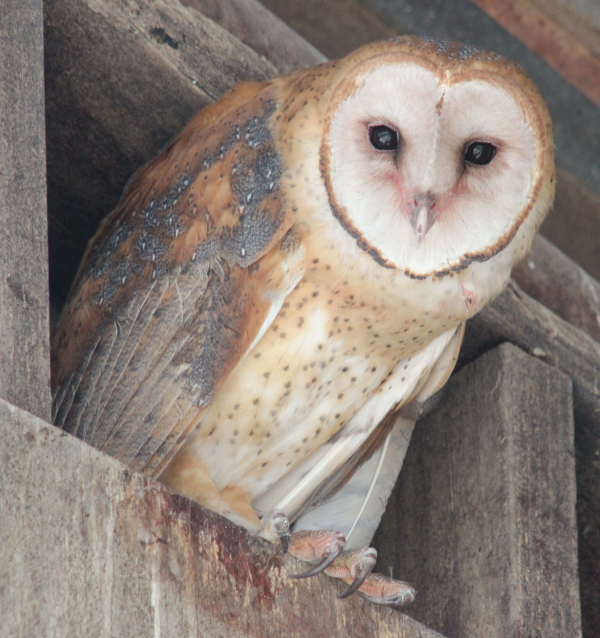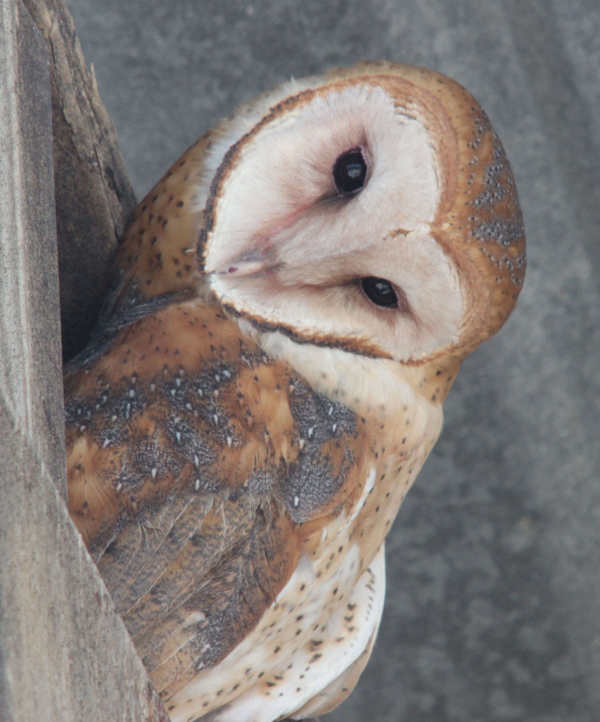I remember seeing my first Barn Owl when I was in high school, perched at the top of a barn silo at a farm I worked at Saturdays and summers on the west side of the Missouri River near Bismarck. The species is exceptionally rare in the cold of the northern plains, and it would be several years before I had a chance to photograph Barn Owls on a farm, in a barn, but this time I was working as a nesting bird biologist east of San Diego.

Later, while working on a field study of nesting birds east of San Diego, I was fortunate enough to monitor hundreds of active bird nests that included 87 different species, stopping at each one weekly to report on the birds’ progress during the nesting period. The nests were initially found and mapped by other biologists along an expansive transect beginning on the east end of San Diego, across the mountain range north of the Mexican border, and down into the desert sands as far as the California border town of Calimex, which is right across the border from Mexicali – ha.
That 3-year project was a highlight of my career – one of many – and among the 87 species of bird nests studied, one of the outstanding nest sites I monitored was located in an old hay barn on a dairy farm – you guessed it, a Barn Owl nest site. By the time this particular nest site was found and I began monitoring it, the 2 nestlings were well-feathered and ready to fledge; in fact, the well-developed nestlings resembled adults.

The feathers of these soon-to-fledge Barn Owls were clean, new, and beautifully colored, making them perfect photo subjects, especially because I could get into position near the barn door to photograph the young owls without worrying about them reacting to my arrival by flying away. Even so, I didn’t want to alarm them into a premature initial flight from the rafters where they were raised, so kept my distance and didn’t make any unnecessary moves.
Photographing in the Barn

In typical owl fashion, when the Barn Owl tipped its head to the side it showed this exceptionally cute look, different from any others (350mm zoom, f-8 aperture, 1/160 shutter speed, 800 ISO).
|
While I usually rely on natural sunlight to illuminate my photo subjects, the young Barn Owls were positioned inside the cover of the wooden metal-roofed barn. Luckily, the nest site where the young owls spent their time was near the tall sliding door that was always half-open, permitting some natural light to bathe the area with low-level ambient light that even reached into the highest point where the west wall met the ceiling. That low light level required some testing to try to get the right camera settings.
In the recess of the weathered wood structure that supported the metal roof, I dialed the ISO setting up to 1600, almost an unheard of ISO for me to use, but this was an extreme case. As it turned out, 1600 was the perfect option, allowing me to use an aperture of f-7, which provided enough of an area in focus to show sharp details of the young owls as well as the surrounding weathered wood. The 1/400 shutter speed helped keep the photos sharp and the combination of all these camera variables provided perfect colors in the birds and their surrounding – but especially in the Barn Owls’ plumage.
At the same time, I was concerned about using the 1600 ISO, thinking there was a chance the resulting photos would show a level of graininess. Therefore, I also used the 800 ISO setting for most of the photos I selected to illustrate this article. Even so, you can see that the photos didn’t suffer much from the slower shutter speeds and narrower apertures – all the photos are sharp, the colors true, and everything in the photos is in focus. Sometimes we try to make the little improvements in our settings, to dial in to get the best out of our photos, and sometimes even when using different settings, it all works out.
Frankly, considering the low level of ambient sunlight, I’m surprised and impressed with the quality of the colors and the sharpness of the images that show no shadows. I’m thrilled that it all worked out, time after time as I checked back on the nearly fledged Barn Owls. Some photographers may ask “why didn’t you use a flash?” Using a flash on owls is always questionable because their eyes are so sensitive, not to mention that flash photography is a whole different bag of worms to try to judge, calculate, and use effectively. I really only use flash in an extreme case, like a night photo.

The adult Barn Owls never showed, which is fairly true to form because young owls tend to constantly beg for food when an adult is in sight. At this point, the adults probably only visited the nest site when they dropped off small rodents and left immediately during the dark of night. Anyway, the 2 young Barn Owls were memorable birds along my weekly San Diego bird nest monitoring route, and I’m always glad to share the photos I took of them, the only Barn Owl photos I’ve taken to date. And that uber-emphasizes the importance of taking advantage of photographing birds when you have the opportunity, whether it’s during a few moments, or over an extended period when you can check back from time to time.
Those were the good ole days, living on the beach, driving into the mountains or desert to study the nesting birds and other wildlife during the week, dating a beautiful woman from Veracruz, Mexico who taught me Spanish and remains one of the loves of my life. I’ve had many fulfilling periods of life that equal those San Diego days, before and since, but man did I have fun among a wonderful group of biologists and other friends that I’ll never forget. Similarly, I remember every nest site, every road, every snake and lizard and bobcat, all of which I photographed, with the young Barn Owls among my favorites – as was Daniela – Te quiero mucho mi bonita amor.
Article and photographs by Paul Konrad
Share your bird photos and birding experiences at editorstbw2@gmail.com